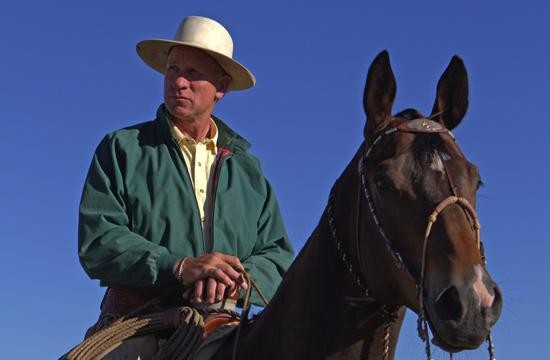
Unveiling the Power of Natural Horsemanship with Buck Brannaman: A Strategy of Respect, Trust, and Understanding
Buck Brannaman, an eminent figure in the equestrian world, has over three decades of horse training experience under his belt. Known for his proficiency in natural horsemanship, Brannaman's techniques focus not just on training but on fostering a deep and holistic bond between horse and rider. His approach is one of collaboration and understanding, driven by the belief that effective communication is the cornerstone of an enduring partnership.
Natural horsemanship is founded on working in harmony with the horse's innate instincts and behaviors. This philosophy hinges on a respect for the horse as an individual and the understanding that each horse is a highly social creature with complex social structures and communication systems. When we learn to interpret their unique language of non-verbal cues, we unlock the possibility of a profound and mutually beneficial relationship.
Another key tenet of natural horsemanship is the use of positive reinforcement. Unlike conventional training methods, which often resort to punitive measures for misbehavior, natural horsemanship encourages reward for correct behavior. This approach not only strengthens the connection between horse and rider but also nurtures a confident, relaxed, and willing equine partner by fostering a secure and enjoyable environment.
Buck Brannaman's natural horsemanship approach revolves around three fundamental principles - groundwork, communication, and riding:
- Groundwork: This involves exercises that focus on the horse's balance, flexibility, and trust while the handler is on the ground. The aim is to cultivate the horse's confidence in the handler and establish a solid foundation for further training.
- Communication: This principle is about teaching the horse to respond to cues in a calm, precise, and consistent manner. Both verbal and non-verbal communication plays a crucial role in this process.
- Riding: The principles of groundwork and communication are brought into practice under the saddle. The goal is to create a calm and responsive horse that is a joy to ride.
Natural horsemanship isn't just for competitive riders or those with specific training objectives. It is a philosophy that can enrich the experience of any horse enthusiast seeking a deeper understanding and connection with these magnificent creatures. By learning to speak the language of the horse, we can tap into their full potential and cultivate a bond of trust and respect that is as rewarding as it is enduring.
In the realm of natural horsemanship, Buck Brannaman stands as a testament to the profound relationships we can forge with horses. His wisdom teaches us that horse training is more than a set of techniques - it's about understanding, respect, and the magical bond that forms when we choose to ride not just with our bodies, but with our hearts too.
Applying Natural Horsemanship Techniques in Show Jumping
Buck Brannaman's natural horsemanship techniques can be invaluable when applied to show jumping horses. The fundamental concepts of trust, communication, and understanding are just as relevant in the show jumping arena as they are in any other horse-human interaction.
- Trust: Show jumping requires the horse to place a lot of trust in the rider. When confronted with a series of jumps, the horse must trust that the rider will guide them safely. This trust is built through consistent, positive interactions, and an understanding of the horse's instincts and behaviors.
- Communication: A successful show jumper communicates effectively with their horse. Clear, consistent cues are crucial in navigating the course effectively and efficiently. The techniques of natural horsemanship can help improve this communication, as they emphasize the importance of non-verbal cues and understanding the horse's body language.
- Groundwork: Much of the training for show jumping can be done from the ground. Brannaman's groundwork techniques can help improve the horse's balance and flexibility, both of which are essential for successful jumping. In addition, groundwork can help build trust and foster a stronger bond between horse and rider.
- Positive Reinforcement: Rewarding a horse for correctly navigating a jump or successfully completing a course reinforces the behavior and makes it more likely to be repeated in the future. This is a core principle of natural horsemanship and can be effectively used in show jumping training.
- Riding: Brannaman's natural horsemanship doesn't stop at the groundwork. When riding, the same principles of communication, understanding, and respect apply. A calm and responsive horse is not only a joy to ride but can also be more successful in the show jumping arena.
Natural horsemanship techniques, when applied correctly, can have a significant impact on a show jumping horse's performance. By building a strong foundation of trust and understanding, riders can develop a deep and fulfilling partnership with their horse. This can lead to improved performance in the show jumping arena and a more rewarding experience for both horse and rider. Remember, the key to successful natural horsemanship is patience and consistency. It may take time, but the results will be well worth the effort.
Innovating the Equine Trade Experience at BRIDL - Bridging the Gap between Buyers and Sellers globally
11moAs a horse enthusiast, this blog resonates deeply with me and serves as a wonderful guide to enhancing our connections with horses in a more profound and respectful manner. Shoutout to some amazing people that have worked with Buck firsthand! 🐴 Patricia Kelley, Noah Cornish, Emma Kline, Greg Eliel